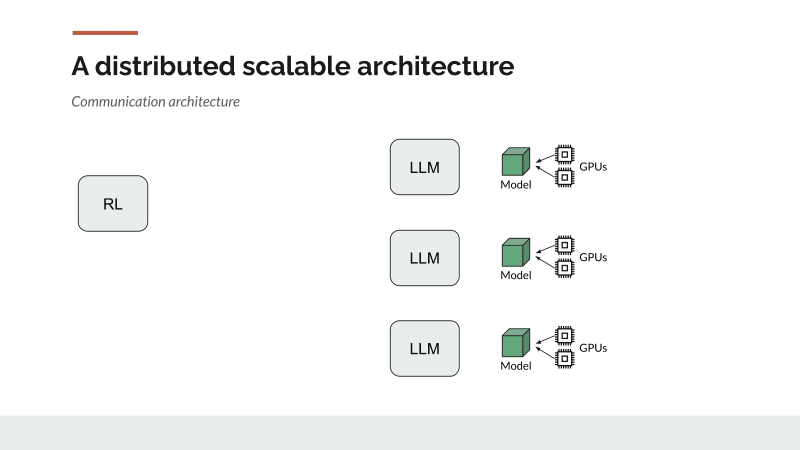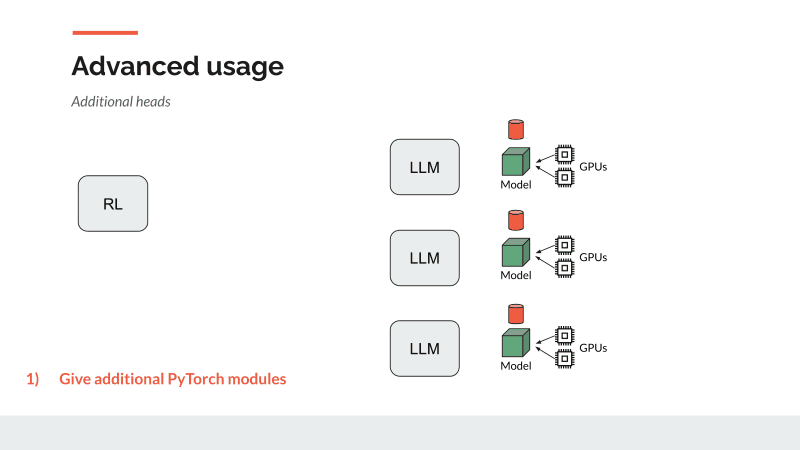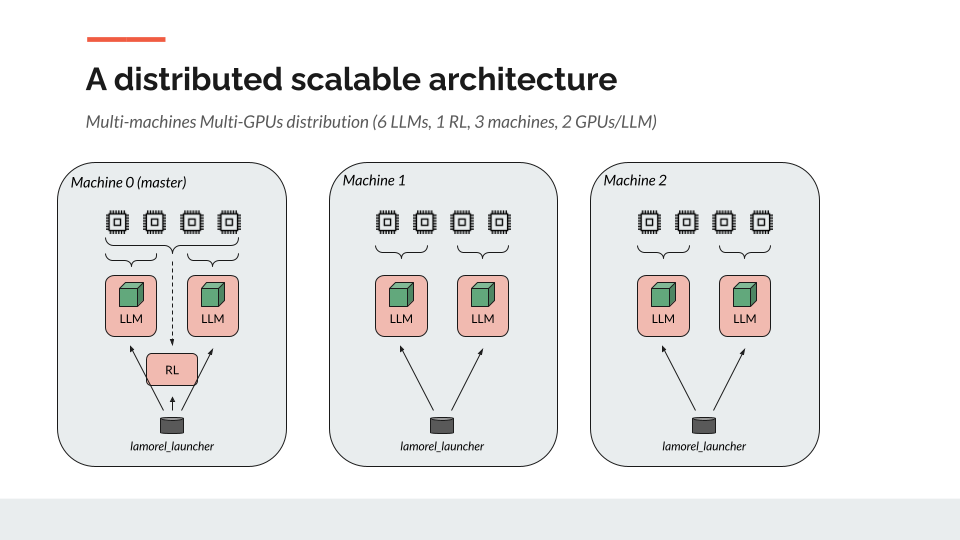Lamorel is a Python library designed for people eager to use Large Language Models (LLMs) in interactive environments (e.g. RL setups).
First of all, Lamorel was initially designed to easily use LLMs in interactive environments. For this reason, it is not specialised in RL. However, one can easily implement an RL loop as provided in examples.
A key component of RLHF is that generating a sequence of tokens given a prompt is considered as a full (and terminated) episode. Steps are therefore the generation of each token in the generated sequence. This method is for instance useful to finetune LLMs to generate token sequences that maximize a reward function (e.g. learned from interactions with humans). However, this setup is not suited for interacting with an external environment that requires multiple interactions (e.g. multiple text generations) to end an episode.
This is why we advise users that lie in the RLHF setup and do not want to reimplement the RL loop by themselves to use such libs that already come with RL implementations (e.g. RL4LMs, TRL). On the opposite, if you want to use your LLM in an interactive environment where acting in the environment leads your agent to a new state (and possibly a new prompt for your LLM) that is still part of the same episode, Lamorel may help you.
- Abstracts the use of LLMs (e.g. tonekization, batches) into simple calls
lm_server.generate(contexts=["This is an examples prompt, continue it with"])
lm_server.score(contexts=["This is an examples prompt, continue it with"], candidates=["a sentence", "another sentence"])- Provides a method to compute the probability of token sequences (e.g. action commands) given a prompt
- Is made for scaling up your experiments by deploying multiple instances of the LLM and dispatching the computation thanks to a simple configuration file
distributed_setup_args:
n_rl_processes: 1
n_llm_processes: 1- Provides access to open-sourced LLMs from the Hugging Face's hub along with Model Parallelism to use multiple GPUs for an LLM instance
llm_args:
model_type: seq2seq
model_path: t5-small
pretrained: true
minibatch_size: 4
parallelism:
use_gpu: true
model_parallelism_size: 2- Allows one to give their own PyTorch modules to compute custom operations (e.g. to add new heads on top of the LLM)
- Allows one to train the LLM (or part of it) thanks to a Data Parallelism setup where the user provides its own update method
Lamorel relies on a client-server(s) architecture where your RL script acts as the client sending requests to the LLM server(s). In order to match the computation requirements of RL, Lamorel can deploy multiple LLM servers and dispatch the requests on them without any modification in your code.

cd lamorelpip install .
We provide a set of examples that use Lamorel in interactive environments:
- SayCan: A SayCan implementation that controls a robot hand in a simulated PickPlace environment.
- PPO_finetuning: A lightweight implementation of the PPO approach introduced in "Grounding Large Language Models in Interactive Environments with Online Reinforcement Learning" to finetune an LLM policy in BabyAI-Text.
Lamorel is built of three main components:
- a Python API to interact with LLMs
- a configuration file to set the LLM servers
- a launcher deploying the multiple LLM servers and launching your RL script
Lamorel leverages hydra for its configuration file. Because of this, you need to add the hydra decorator on top of your main function.
Then, you must instantiate the Caller class from Lamorel which will create the object allowing you to interact with the LLM servers.
Do not forget to initialize Lamorel once imported with lamorel_init() to initialize the communication with the servers.
import hydra
from lamorel import Caller, lamorel_init
lamorel_init()
@hydra.main(config_path='../config', config_name='config')
def main(config_args):
lm_server = Caller(config_args.lamorel_args)
# Do whatever you want with your LLM
lm_server.close()
if __name__ == '__main__':
main()Do not forget to close the connection with servers at the end of your script.
Once instantiated, you can use the different methods of the Caller object to send requests to your LLMs.
First, we provide the score method to compute the probability of a sequence of tokens (a candidate) given a prompt (context).
Lamorel allows to provide multiple candidates for a single context but also to batch this computation for multiple contexts (along with their associated candidates). Using this, one can use a classic vectorized RL setup where at each step, multiple environments running in parallel return their current state and expect an action.
lm_server.score(contexts=["This is an examples prompt, continue it with"],
candidates=[["a sentence", "another sentence"]])Lamorel also provides a method for text generation. Similarly to the score method, one can give multiple prompts (contexts).
Our generate method can use any keyword argument from Transformers API.
In addition of the generated texts, it also returns the probability of each generated sequence.
lm_server.generate(contexts=["This is an examples prompt, continue it with"])
lm_server.generate(contexts=["This is an examples prompt, continue it with"], temperature=0.1, max_length=25)While Lamorel provides two main uses of LLMs (i.e. scoring and generating), we also allow users to provide their own methods to perform custom operations using LLMs.
We expect these custom methods to be PyTorch modules.

In order to define such a custom operation, users must extend our BaseModuleFunction class.
For this, you must extend two main methods:
initialize(self): initialize your custom operations here.forward(self, forward_outputs, minibatch, tokenized_context, **kwargs): perform your operations here and return the results.
Lamorel will give your custom module to all LLM servers and ensure your variables (e.g. weights) are the same on each server. See the example below where we implement a Multi Layer Perceptron (MLP) on top of our LLM.
from lamorel import BaseModuleFunction
class TwoLayersMLPModuleFn(BaseModuleFunction):
def __init__(self, model_type, n_outputs):
super().__init__()
self._model_type = model_type
self._n_outputs = n_outputs
def initialize(self):
'''
Use this method to initialize your module operations.
- self.llm_config gives the configuration of the LLM (e.g. useful to know the size of representations)
- self.device gives you access to the main device (e.g. GPU) the LLM is using
'''
llm_hidden_size = self.llm_config.to_dict()[self.llm_config.attribute_map['hidden_size']]
self.mlp = torch.nn.Sequential(
torch.nn.Linear(llm_hidden_size, 128),
torch.nn.Linear(128, 128),
torch.nn.Linear(128, self._n_outputs),
).to(self.device)
def forward(self, forward_outputs, minibatch, tokenized_context, **kwargs):
'''
Perform your operations here.
- forward_outputs gives access the output of the computations performed by the LLM (e.g. representations of each layer)
- minibatch gives access to the input data (i.e. a prompt and multiple candidates) given to the LLM
- tokenized_context gives access to the prompt used
'''
# Get the last layer's representation from the token right after the prompt
if self._model_type == "causal": # adapt to the Transformers API differing between Encoder-Decoder and Decoder-only models
model_head = forward_outputs['hidden_states'][0][0, len(tokenized_context["input_ids"])-1, :]
else:
model_head = forward_outputs['encoder_last_hidden_state'][0, len(tokenized_context["input_ids"]) - 1, :]
# Give representation to our MLP
output = self.mlp(model_head)
return outputOnce implemented, you can give your custom module(s) to the Lamorel Caller (along with a key). It will then be possible to use your module:
- either by calling it directly using the
custom_module_fns - or by using it in addition of scoring
lm_server = Caller(config_args.lamorel_args,
custom_module_functions={
'mlp_head': TwoLayersMLPModuleFn(config_args.lamorel_args.llm_args.model_type, 2)
})
# Direct call
lm_server.custom_module_fns(module_function_keys=['mlp_head'],
contexts=["This is an examples prompt, continue it with"])
# Scoring
lm_server.score(additional_module_function_keys=['mlp_head'],
contexts=["This is an examples prompt, continue it with"],
candidates=["a sentence", "another sentence"])We have seen so far how to use an LLM (along with possibly custom modules) for inference. However, Lamorel also provides tools to update (e.g. train) these operations with a BaseUpdater class which can be extended and perform any update operation. Our class gives access to the whole computation graph self._llm_module.
It can for instance be used to perform operations with gradient by calling self._llm_module(['mlp_head', '__score'], ...) with the leaf operations wanted (i.e. scoring and/or custom modules) or to select weights to train (the LLM itself self._llm_module._LLM_model, custom modules self._llm_module.module._module_functions, the whole graph self._llm_module).
from lamorel import BaseUpdater
class TestUpdater(BaseUpdater):
def perform_update(self, contexts, candidates, _current_batch_ids, **kwargs):
if not hasattr(self, 'loss_fn'):
self.loss_fn = torch.nn.CrossEntropyLoss()
if not hasattr(self, 'optimizer'):
# You can train:
# 1. Only the LLM
# self.optimizer = torch.optim.Adam(self._llm_module._LLM_model.parameters())
# 2. Only some custom modules
self.optimizer = torch.optim.Adam(self._llm_module.module._module_functions["mlp_head"].parameters())
# 3. Everything
# self.optimizer = torch.optim.Adam(self._llm_module.parameters())
# Use the computational graph with gradient
# 1. Only the LLM's scoring module
# output = self._llm_module(['__score'], contexts=contexts, require_grad=True)
# 2. Only some custom modules
output = self._llm_module(['mlp_head'], contexts=contexts, require_grad=True)
# 3. Both
# output = self._llm_module(['__score', 'mlp_head'], contexts=contexts, require_grad=True)
# Stack outputs to batch loss computation
stacked_output = torch.stack([_o["mlp_head"] for _o in output]).to('cpu')
# Compute loss with the labels corresponding to the current batch
loss = self.loss_fn(stacked_output, kwargs["labels"][_current_batch_ids, :])
# Compute gradients and update graph
loss.backward()
self.optimizer.step()
self.optimizer.zero_grad()
# Return anything you want using a dictionary
return {"loss": loss}Once defined, users must give their custom Updater to the Caller. Note that Updater's constructor can take keyword arguments using config files (see next section).
Whenever needed, users can call their Updater with data (i.e. contexts and candidates) along with any additional keyword argument (e.g. labels).
Because multiple LLM servers can be deployed, we also dispatch the Updater's computation. When one calls the Updater with data, contexts and candidates are dispatched over the multiple servers (where each runs the Updater).
Because Lamorel does not know a priori what additional keyword arguments are, these are copied and sent to each LLM. As users may need to know how to associate these arguments to the data handled by the current server,
we provide the _current_batch_ids variable giving the indexes of contexts (and by extension candidates) that are given to the current LLM.
Lamorel is in charge of gathering the gradients of all servers such that self.optimizer.step() produces the same on each server.
lm_server = Caller(config_args.lamorel_args,
custom_module_functions={
'mlp_head': TwoLayersMLPModuleFn(config_args.lamorel_args.llm_args.model_type, 2)
},
custom_updater_class=TestUpdater)
result = lm_server.update(
contexts=["This is an examples prompt, continue it with"],
candidates=["a sentence"],
labels=torch.tensor([0, 1], dtype=torch.float32),
)
losses = [r["loss"] for r in result] # one loss returned per LLMThe configuration of the LLM and the client-server(s) architecture is done using a YAML configuration file following hydra's API. Here is what this file should contain:
lamorel_args: # Arguments for Lamorel
log_level: debug # (debug, info, error): level of logs returned by Lamorel
allow_subgraph_use_whith_gradient: false #
distributed_setup_args: # Use this section to specify how many LLM servers must be deployed
n_rl_processes: 1
n_llm_processes: 1 # LLM servers
accelerate_args: # Lamorel leverages Hugging Face Accelerate for the distributed setup
config_file: accelerate/default_config.yaml # keep this
machine_rank: ??? # each machine should launch the script and provide its rank (id), see section below
num_machines: 2 # number of machines used in the experiment
llm_args: # Specify which LLM to use and how
model_type: seq2seq # (seq2seq, causal): Encoder-Decoder or Decoder-Only model
model_path: t5-small # name (if downloaded from the Hugging Face's hub) or (absolute) path to the model
pretrained: true # (true, false): set this to false if you want to keep the LLM's architecture but re-initialize its wegihts
minibatch_size: 4 # number of candidates to batch per forward, adapt this number to your GPU memory
parallelism: # Model parallelism
use_gpu: true # (true, false) set this to false if you want your LLM(s) to use CPU
model_parallelism_size: 1 # number of GPUs user per LLM server
synchronize_gpus_after_scoring: false # only useful for specific GPU optimizations
empty_cuda_cache_after_scoring: false # only useful for specific GPU optimizations
updater_args: # add here args you would like to give to your Updater's constructor
rl_script_args: # Arguments for Lamorel
path: ??? # absolute path to your RL script
# Provide any additional arguments for your RL script hereExamples of configuration files are provided in section below.
Lamorel comes with a launcher that handles how to launch multiple processes on each machine. To launch your experiment on a machine, you must use the following command:
python -m lamorel_launcher.launch --config-path <path> --config-name <name> rl_script_args.path=<path> lamorel_args.accelerate_args.machine_rank=<rank> <additional arguments to override config>
Warning: use absolute paths
Several examples of configurations can be found in examples.
- Config: local_cpu_config.yaml
- Launch command(s):
-
python -m lamorel_launcher.launch --config-path absolute/path/to/project/examples/configs --config-name local_cpu_config rl_script_args.path=absolute/path/to/project/examples/example_script.py
-
- Config: local_gpu_config.yaml
- Launch command(s):
-
python -m lamorel_launcher.launch --config-path absolute/path/to/project/examples/configs --config-name local_gpu_config rl_script_args.path=absolute/path/to/project/examples/example_script.py
-
If you do not want your LLM process to use all your GPUs (for instance if you plan to launch multiple LLM servers), set an appropriate value to model_parallelism_size in the config.
We here provide an example with a SLURM cluster where our experiment deploys 6 LLM servers on 3 machines. As the schema below shows, the first machine hosts 2 LLM servers and the RL script (which also has access to GPUs).
The two other machines both host only 2 LLM servers.

- Config: multi-node_slurm_cluster_config.yaml
- Launch command(s):
-
sbatch examples/slurm/job.slurm
-
Lamorel relies on Pytorch distributed for communications. We chose to use the GLOO backend to allow both CPU and GPU platforms.
Lamorel launches the RL script n_rl_processes + n_llm_processes times. Every time it reaches the lm_server = Caller(...) line, Lamorel checks whether the current process should be part of the client or the LLM servers.
If it is a client, the script returns the Caller object (that the user can use to send requests) and continues.
Otherwise, it creates a Server that loads the LLM and starts listening.
For the communication between the client and servers, we create a process group between the client and one of the servers which is considered as the master.
This master server listens to requests and dispatches calls (using the Dispatcher) to all the servers using another process group (only shared by LLM servers).
Each LLM server performs the asked operations on its received data and sends the results to the master LLM server. The latter gathers results and sends them back to the RL script.
Lamorel is still in its very early phase and we are happy to accept any external contribution to it. Please follow the CONTRIBUTING.md file.
